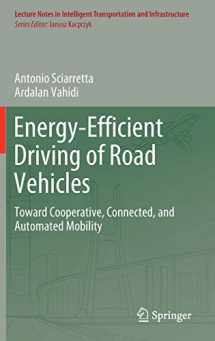
Energy-Efficient Driving of Road Vehicles: Toward Cooperative, Connected, and Automated Mobility (Lecture Notes in Intelligent Transportation and Infrastructure)
ISBN-13:
9783030241261
ISBN-10:
3030241262
Edition:
1st ed. 2020
Author:
Antonio Sciarretta, Ardalan Vahidi
Publication date:
2019
Publisher:
Springer
Format:
Hardcover
313 pages
FREE US shipping
Book details
ISBN-13:
9783030241261
ISBN-10:
3030241262
Edition:
1st ed. 2020
Author:
Antonio Sciarretta, Ardalan Vahidi
Publication date:
2019
Publisher:
Springer
Format:
Hardcover
313 pages
Summary
Energy-Efficient Driving of Road Vehicles: Toward Cooperative, Connected, and Automated Mobility (Lecture Notes in Intelligent Transportation and Infrastructure) (ISBN-13: 9783030241261 and ISBN-10: 3030241262), written by authors
Antonio Sciarretta, Ardalan Vahidi, was published by Springer in 2019.
With an overall rating of 3.9 stars, it's a notable title among other
books. You can easily purchase or rent Energy-Efficient Driving of Road Vehicles: Toward Cooperative, Connected, and Automated Mobility (Lecture Notes in Intelligent Transportation and Infrastructure) (Hardcover) from BooksRun,
along with many other new and used
books
and textbooks.
And, if you're looking to sell your copy, our current buyback offer is $0.3.
Description
This book elaborates the science and engineering basis for energy-efficient driving in conventional and autonomous cars. After covering the physics of energy-efficient motion in conventional, hybrid, and electric powertrains, the book chiefly focuses on the energy-saving potential of connected and automated vehicles. It reveals how being connected to other vehicles and the infrastructure enables the anticipation of upcoming driving-relevant factors, e.g. hills, curves, slow traffic, state of traffic signals, and movements of nearby vehicles. In turn, automation allows vehicles to adjust their motion more precisely in anticipation of upcoming events, and to save energy. Lastly, the energy-efficient motion of connected and automated vehicles could have a harmonizing effect on mixed traffic, leading to additional energy savings for neighboring vehicles. Building on classical methods of powertrain modeling, optimization, and optimal control, the book further develops the theory of energy-efficient driving. In addition, it presents numerous theoretical and applied case studies that highlight the real-world implications of the theory developed. The book is chiefly intended for undergraduate and graduate engineering students and industry practitioners with a background in mechanical, electrical, or automotive engineering, computer science or robotics.


We would LOVE it if you could help us and other readers by reviewing the book
Book review

Congratulations! We have received your book review.
{user}
{createdAt}
by {truncated_author}


